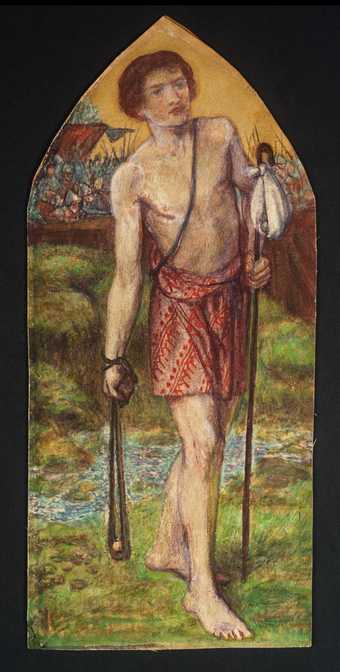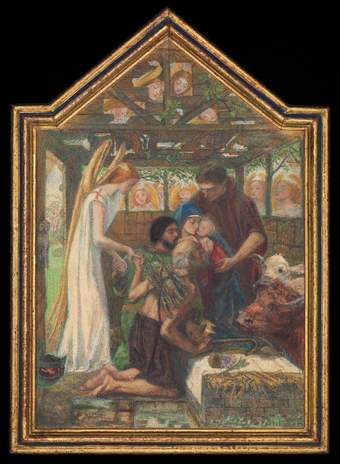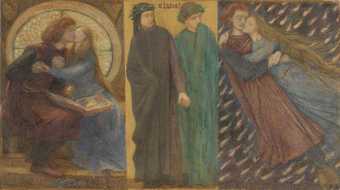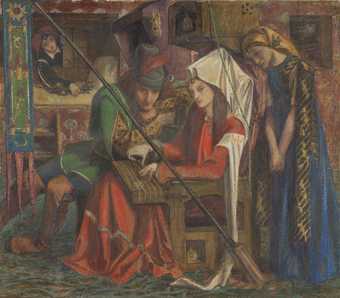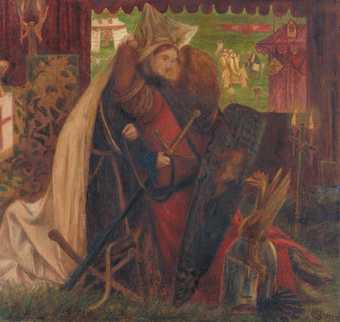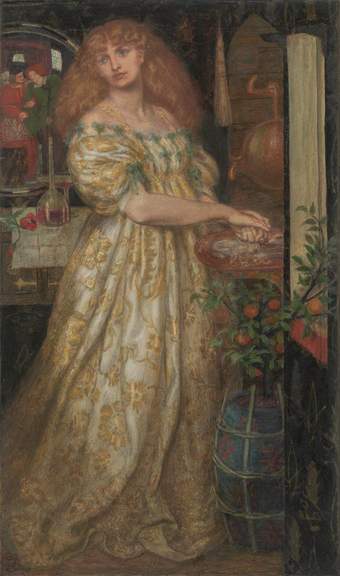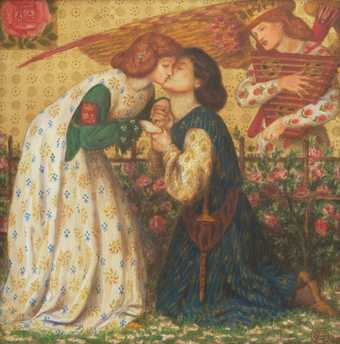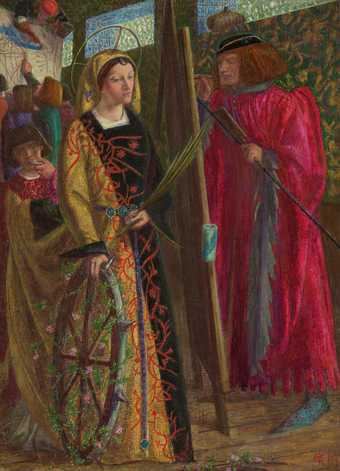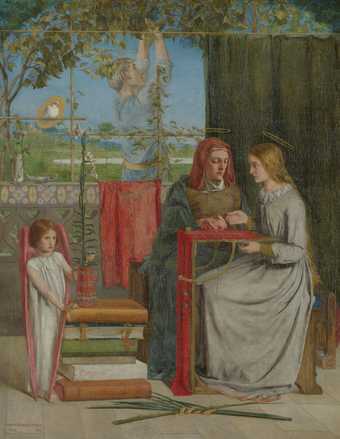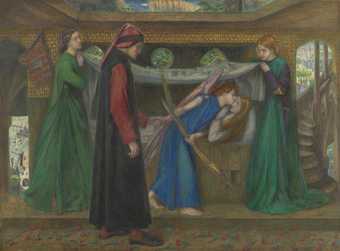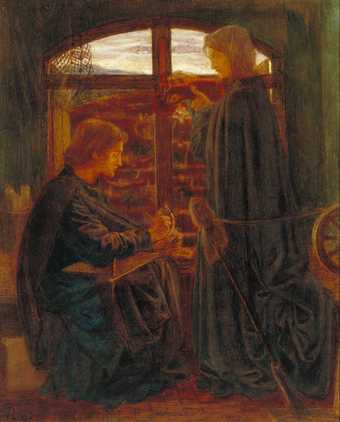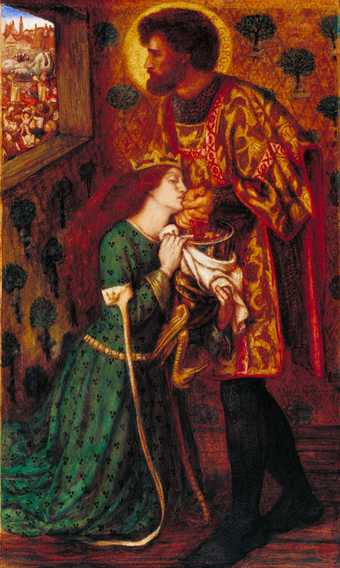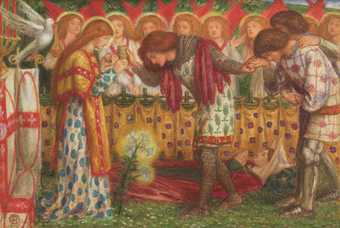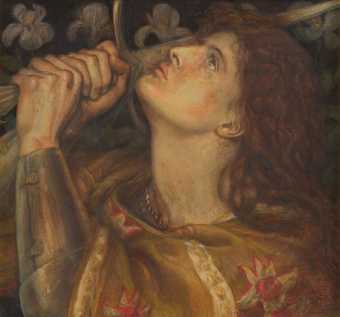
In Tate Britain
Exhibition
- Artist
- Dante Gabriel Rossetti 1828–1882
- Medium
- Watercolour on paper
- Dimensions
- Support: 354 × 260 mm
frame: 550 × 454 × 45 mm - Collection
- Tate
- Acquisition
- Purchased with assistance from Sir Arthur Du Cros Bt and Sir Otto Beit KCMG through the Art Fund 1916
- Reference
- N03057
Summary
This watercolour is in the medievalising style of Rossetti's earlier works. It is one of a series of similar subjects that Rossetti painted for William Morris. Rossetti described the picture simply as 'some people playing music' (Doughty & Wahl I, p.376), but it may have been loosely inspired by Tennyson's Morte d'Arthur and possibly also Villon's Ballad of Dead Ladies, which Rossetti translated. Morris was so intrigued by The Blue Closet that in 1856, a year before the date inscribed on the watercolour, he wrote a poem based on its enigmatic subject matter:
Alice the Queen and Louise the Queen,
Two damozels wearing purple and green
Four lone ladies dwelling here
From day to day and year to year
Morris's interpretation is purely subjective, and Rossetti commented that, 'though beautiful in themselves,' his poems 'were the result of the pictures, but don't at all tally to any purpose with them.'(G.S. Layard, Tennyson and his Pre-Raphaelite Illustrators, 1894, p.55.)
The four women in medieval dress are playing a curious hybrid musical instrument and singing from sheets of music. They stand in a room lined with blue tiles. Frederic Stephens, a member of the Pre-Raphaelite Brotherhood, later commented on the correspondence between colours and sounds: 'The sharp accents of the scarlet and green seem to go with the sound of the bell', while 'the softer crimson, purple and white accord with the throbbing notes of the lute and clavichord, while the dulcet, flute-like voices of the girls appear to agree with those azure tiles on the wall and floor' (quoted in Marsh 1999, p.171).
The symmetrical grouping of the figures recalls the composition of medieval scenes of angels making music (such as Orcagna's panel of Musical Angels in Christ Church Oxford). The sprigs of holly lying across the top of the instrument may be intended to denote the time of year. They are balanced by the red-orange lily at the foot of the picture, which Morris's poem links with death. Various enigmatic devices on the side of the instrument remain too esoteric to interpret, but the symbol of the sun and moon is frequently used by Rossetti to suggest the passage of time.
Further reading:
Oswald Doughty and J.R. Wahl (eds), Letters of Dante Gabriel Rossetti, 4 vols., Oxford 1965-7.
Leslie Parris (ed.), The Pre-Raphaelites, exhibition catalogue, Tate Gallery, London 1984, reprinted 1994, p.280, reproduced p.280, in colour.
Elizabeth Prettejohn, The Art of the Pre-Raphaelites, London 2000, p.119, reproduced p.118, in colour.
Virginia Surtees, The Paintings and Drawings of Dante Gabriel Rossetti (1828-1882) - A Catalogue Raisonné, 2 vols., Oxford 1971, p.50, no.90, reproduced pl.115.
Frances Fowle
8 December 2000
Does this text contain inaccurate information or language that you feel we should improve or change? We would like to hear from you.
Display caption
Rossetti worked on this watercolour shortly after making illustrations for an edition of Tennyson's poems. Consequently its subject has been related to Tennyson's description of King Arthur's death. However Rossetti himself described it simply as 'some people playing music'. Its title is derived from the blue tiles on the walls of the room.
Although dated 1857, Rossetti must have nearly finished the work before the end of 1856, when Morris wrote a poem inspired by it. This was included in his 1858 volume, The Defence of Guenevere and Other Poems. Morris was also the first owner of the work.
Gallery label, September 2004
Does this text contain inaccurate information or language that you feel we should improve or change? We would like to hear from you.
Film and audio
Explore
- history(5,776)
-
- politics and society(2,337)
- domestic(1,795)
- music and entertainment(2,331)
- clothing and personal items(5,879)
-
- headdress(136)
- sheet music(27)
- group(4,227)
- abstract concepts(119)
You might like
-
Dante Gabriel Rossetti David
1858–64 -
Dante Gabriel Rossetti The Adoration
1858–64 -
Dante Gabriel Rossetti Paolo and Francesca da Rimini
1855 -
Dante Gabriel Rossetti The Tune of the Seven Towers
1857 -
Dante Gabriel Rossetti The Chapel before the Lists
1857–64 -
Dante Gabriel Rossetti Lucrezia Borgia
1860–1 -
Dante Gabriel Rossetti Roman de la Rose
1864 -
Dante Gabriel Rossetti St Catherine
1857 -
Dante Gabriel Rossetti The Girlhood of Mary Virgin
1848–9 -
Dante Gabriel Rossetti Dante’s Vision of Rachel and Leah
1855 -
Dante Gabriel Rossetti Dante’s Dream at the Time of the Death of Beatrice
1856 -
Dante Gabriel Rossetti Mary in the House of St John
1859 -
Dante Gabriel Rossetti St George and Princess Sabra
1862 -
Dante Gabriel Rossetti Joan of Arc
1864

